Mental Health and Wellness Report: Chung's Case Study Analysis
VerifiedAdded on 2023/06/05
|6
|1258
|376
Report
AI Summary
This report presents a comprehensive analysis of a mental health case study involving a patient named Chung. The report delves into Chung's suicidal thoughts, identifying risk factors such as hopelessness, work pressure, and strained family connections. It also explores the patient's anxiety, manifested through palpitations and shortness of breath, linking it to long working hours and family issues. The report emphasizes crucial nursing interventions, including creating a suicide-safe environment by removing potential hazards and utilizing therapeutic techniques like watching television and listening to music to reduce anxiety. Furthermore, the report highlights the importance of respecting patient confidentiality and promoting autonomy in accordance with the Mental Health Act and Nursing and Midwifery Board Australia (NMBA) standards. The analysis incorporates relevant research to support the recommended interventions and ethical considerations in mental health care.
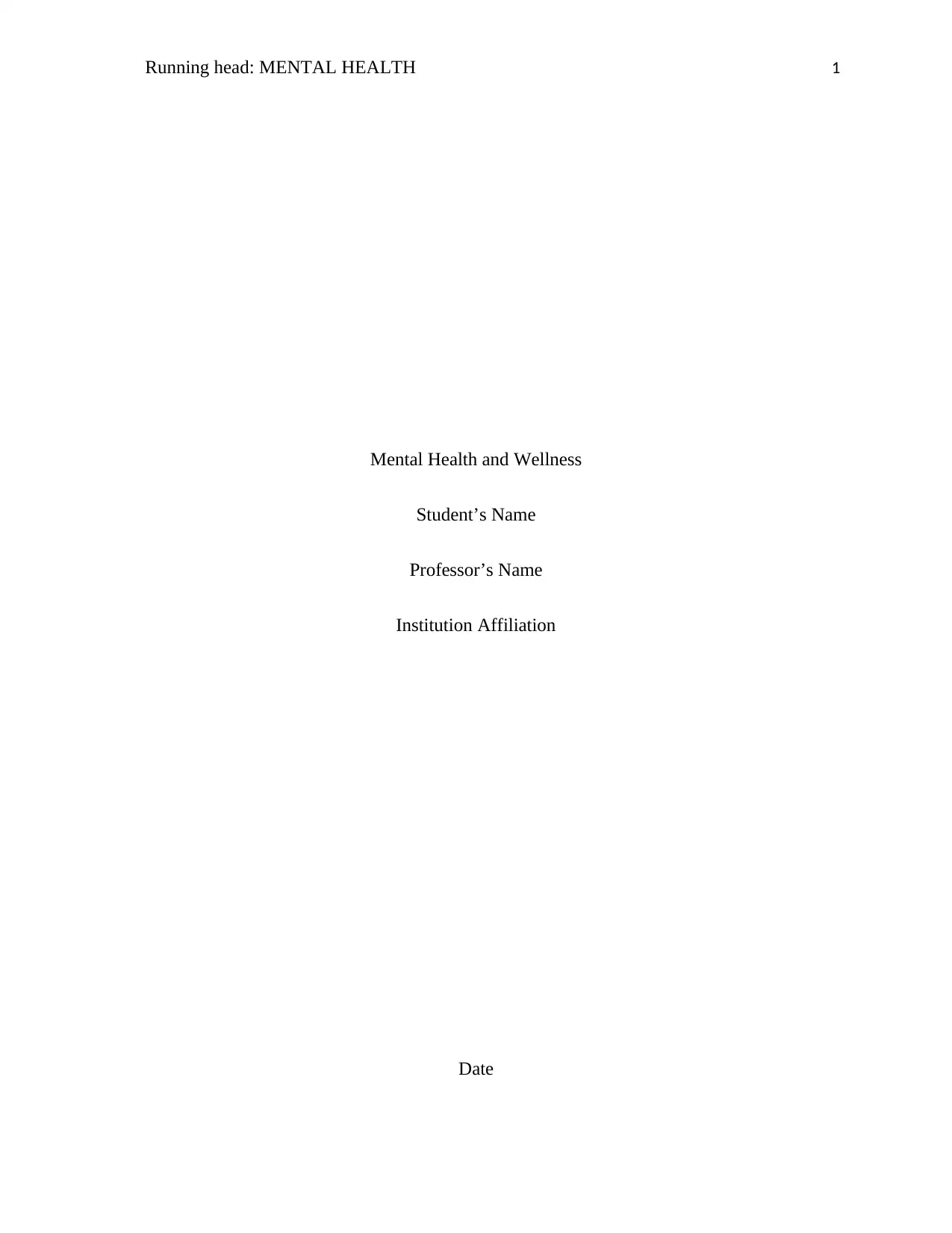
Running head: MENTAL HEALTH 1
Mental Health and Wellness
Student’s Name
Professor’s Name
Institution Affiliation
Date
Mental Health and Wellness
Student’s Name
Professor’s Name
Institution Affiliation
Date
Paraphrase This Document
Need a fresh take? Get an instant paraphrase of this document with our AI Paraphraser
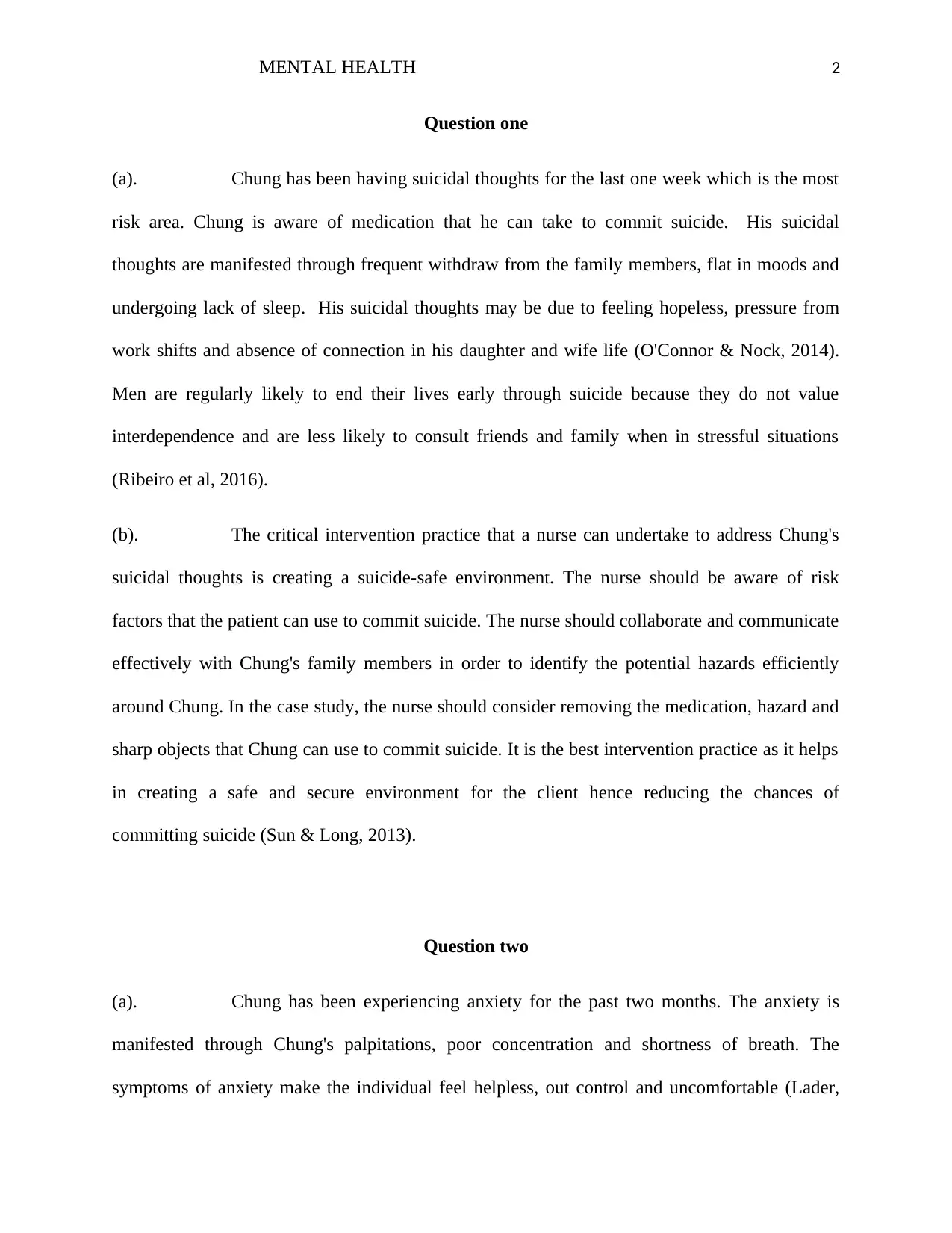
MENTAL HEALTH 2
Question one
(a). Chung has been having suicidal thoughts for the last one week which is the most
risk area. Chung is aware of medication that he can take to commit suicide. His suicidal
thoughts are manifested through frequent withdraw from the family members, flat in moods and
undergoing lack of sleep. His suicidal thoughts may be due to feeling hopeless, pressure from
work shifts and absence of connection in his daughter and wife life (O'Connor & Nock, 2014).
Men are regularly likely to end their lives early through suicide because they do not value
interdependence and are less likely to consult friends and family when in stressful situations
(Ribeiro et al, 2016).
(b). The critical intervention practice that a nurse can undertake to address Chung's
suicidal thoughts is creating a suicide-safe environment. The nurse should be aware of risk
factors that the patient can use to commit suicide. The nurse should collaborate and communicate
effectively with Chung's family members in order to identify the potential hazards efficiently
around Chung. In the case study, the nurse should consider removing the medication, hazard and
sharp objects that Chung can use to commit suicide. It is the best intervention practice as it helps
in creating a safe and secure environment for the client hence reducing the chances of
committing suicide (Sun & Long, 2013).
Question two
(a). Chung has been experiencing anxiety for the past two months. The anxiety is
manifested through Chung's palpitations, poor concentration and shortness of breath. The
symptoms of anxiety make the individual feel helpless, out control and uncomfortable (Lader,
Question one
(a). Chung has been having suicidal thoughts for the last one week which is the most
risk area. Chung is aware of medication that he can take to commit suicide. His suicidal
thoughts are manifested through frequent withdraw from the family members, flat in moods and
undergoing lack of sleep. His suicidal thoughts may be due to feeling hopeless, pressure from
work shifts and absence of connection in his daughter and wife life (O'Connor & Nock, 2014).
Men are regularly likely to end their lives early through suicide because they do not value
interdependence and are less likely to consult friends and family when in stressful situations
(Ribeiro et al, 2016).
(b). The critical intervention practice that a nurse can undertake to address Chung's
suicidal thoughts is creating a suicide-safe environment. The nurse should be aware of risk
factors that the patient can use to commit suicide. The nurse should collaborate and communicate
effectively with Chung's family members in order to identify the potential hazards efficiently
around Chung. In the case study, the nurse should consider removing the medication, hazard and
sharp objects that Chung can use to commit suicide. It is the best intervention practice as it helps
in creating a safe and secure environment for the client hence reducing the chances of
committing suicide (Sun & Long, 2013).
Question two
(a). Chung has been experiencing anxiety for the past two months. The anxiety is
manifested through Chung's palpitations, poor concentration and shortness of breath. The
symptoms of anxiety make the individual feel helpless, out control and uncomfortable (Lader,
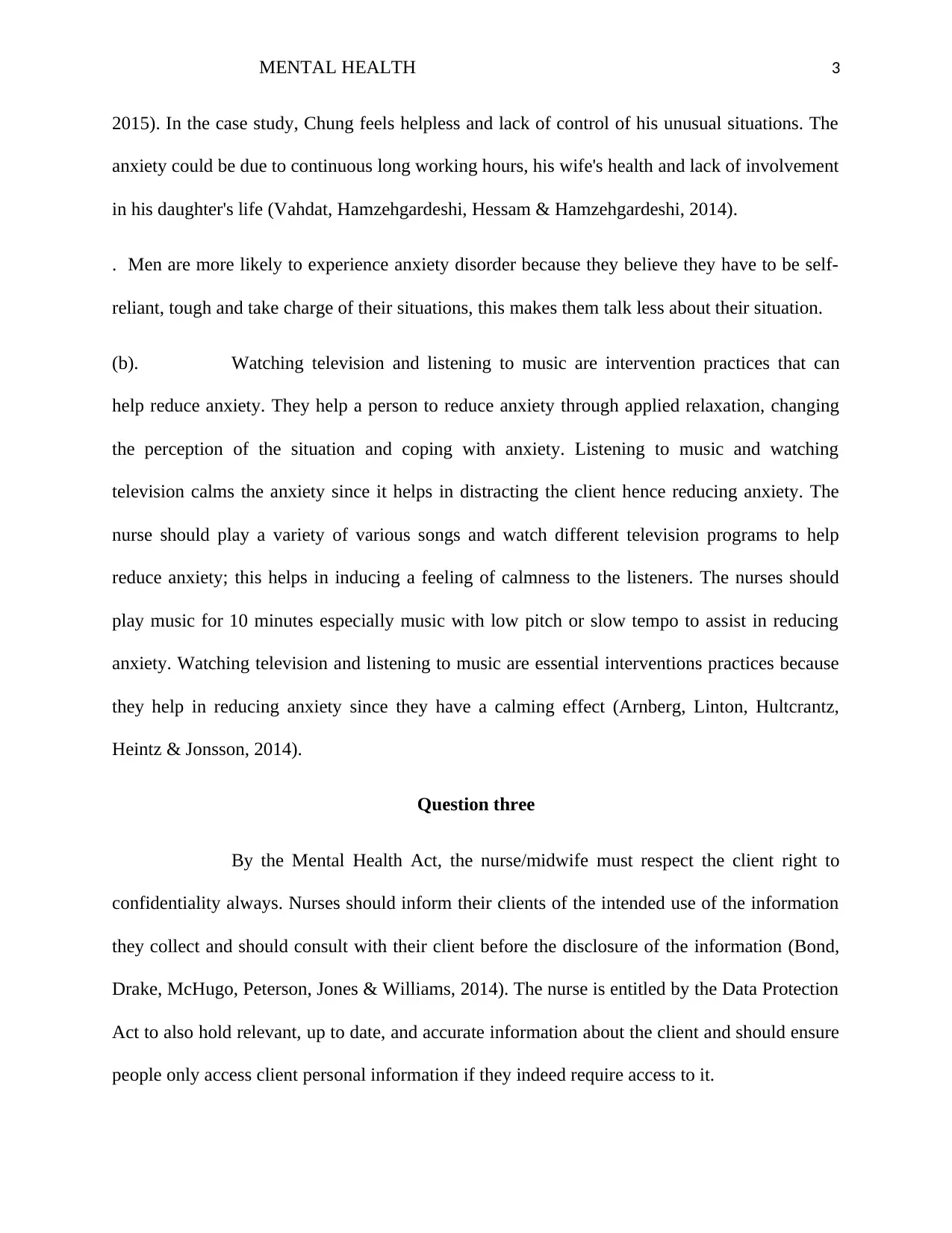
MENTAL HEALTH 3
2015). In the case study, Chung feels helpless and lack of control of his unusual situations. The
anxiety could be due to continuous long working hours, his wife's health and lack of involvement
in his daughter's life (Vahdat, Hamzehgardeshi, Hessam & Hamzehgardeshi, 2014).
. Men are more likely to experience anxiety disorder because they believe they have to be self-
reliant, tough and take charge of their situations, this makes them talk less about their situation.
(b). Watching television and listening to music are intervention practices that can
help reduce anxiety. They help a person to reduce anxiety through applied relaxation, changing
the perception of the situation and coping with anxiety. Listening to music and watching
television calms the anxiety since it helps in distracting the client hence reducing anxiety. The
nurse should play a variety of various songs and watch different television programs to help
reduce anxiety; this helps in inducing a feeling of calmness to the listeners. The nurses should
play music for 10 minutes especially music with low pitch or slow tempo to assist in reducing
anxiety. Watching television and listening to music are essential interventions practices because
they help in reducing anxiety since they have a calming effect (Arnberg, Linton, Hultcrantz,
Heintz & Jonsson, 2014).
Question three
By the Mental Health Act, the nurse/midwife must respect the client right to
confidentiality always. Nurses should inform their clients of the intended use of the information
they collect and should consult with their client before the disclosure of the information (Bond,
Drake, McHugo, Peterson, Jones & Williams, 2014). The nurse is entitled by the Data Protection
Act to also hold relevant, up to date, and accurate information about the client and should ensure
people only access client personal information if they indeed require access to it.
2015). In the case study, Chung feels helpless and lack of control of his unusual situations. The
anxiety could be due to continuous long working hours, his wife's health and lack of involvement
in his daughter's life (Vahdat, Hamzehgardeshi, Hessam & Hamzehgardeshi, 2014).
. Men are more likely to experience anxiety disorder because they believe they have to be self-
reliant, tough and take charge of their situations, this makes them talk less about their situation.
(b). Watching television and listening to music are intervention practices that can
help reduce anxiety. They help a person to reduce anxiety through applied relaxation, changing
the perception of the situation and coping with anxiety. Listening to music and watching
television calms the anxiety since it helps in distracting the client hence reducing anxiety. The
nurse should play a variety of various songs and watch different television programs to help
reduce anxiety; this helps in inducing a feeling of calmness to the listeners. The nurses should
play music for 10 minutes especially music with low pitch or slow tempo to assist in reducing
anxiety. Watching television and listening to music are essential interventions practices because
they help in reducing anxiety since they have a calming effect (Arnberg, Linton, Hultcrantz,
Heintz & Jonsson, 2014).
Question three
By the Mental Health Act, the nurse/midwife must respect the client right to
confidentiality always. Nurses should inform their clients of the intended use of the information
they collect and should consult with their client before the disclosure of the information (Bond,
Drake, McHugo, Peterson, Jones & Williams, 2014). The nurse is entitled by the Data Protection
Act to also hold relevant, up to date, and accurate information about the client and should ensure
people only access client personal information if they indeed require access to it.
⊘ This is a preview!⊘
Do you want full access?
Subscribe today to unlock all pages.

Trusted by 1+ million students worldwide
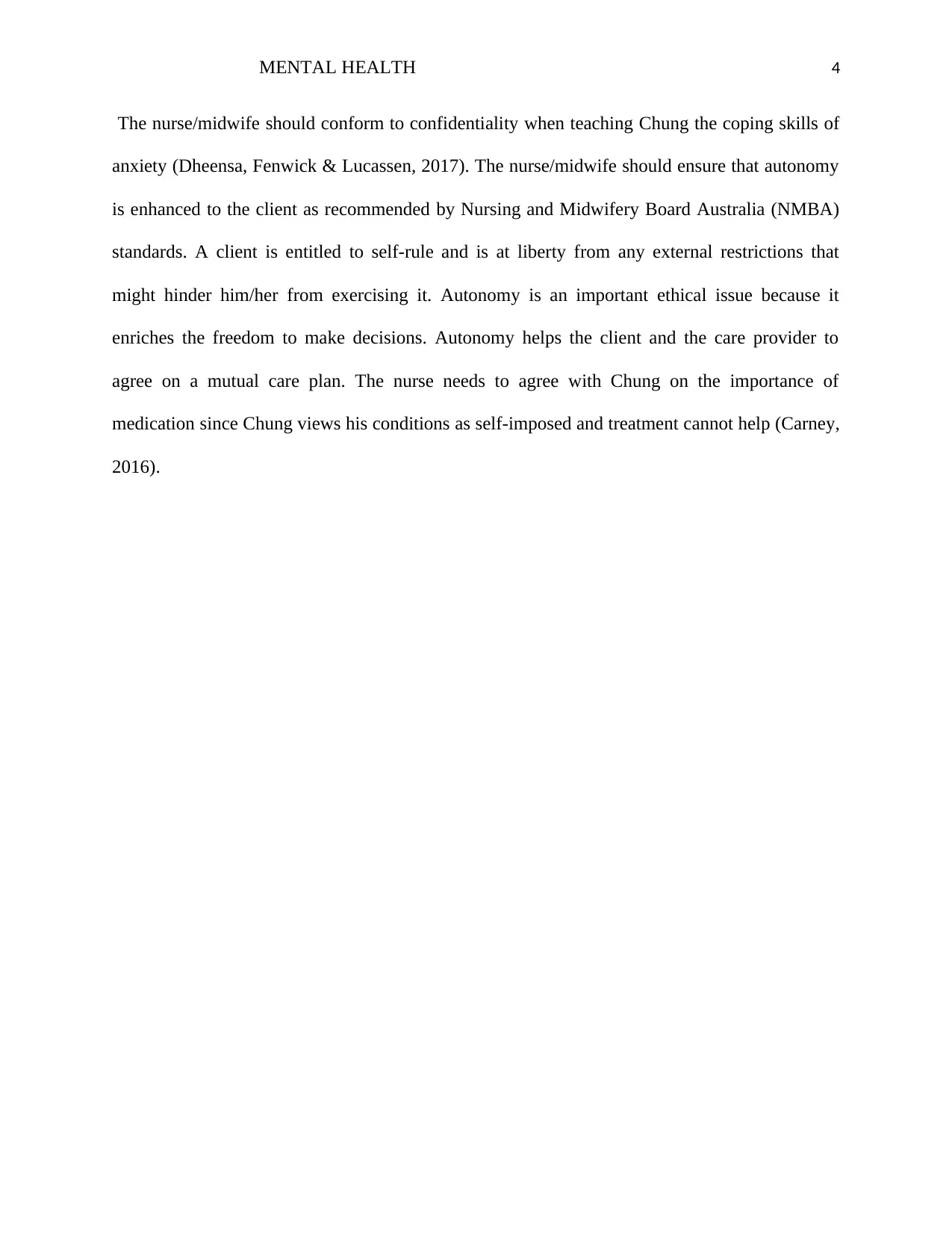
MENTAL HEALTH 4
The nurse/midwife should conform to confidentiality when teaching Chung the coping skills of
anxiety (Dheensa, Fenwick & Lucassen, 2017). The nurse/midwife should ensure that autonomy
is enhanced to the client as recommended by Nursing and Midwifery Board Australia (NMBA)
standards. A client is entitled to self-rule and is at liberty from any external restrictions that
might hinder him/her from exercising it. Autonomy is an important ethical issue because it
enriches the freedom to make decisions. Autonomy helps the client and the care provider to
agree on a mutual care plan. The nurse needs to agree with Chung on the importance of
medication since Chung views his conditions as self-imposed and treatment cannot help (Carney,
2016).
The nurse/midwife should conform to confidentiality when teaching Chung the coping skills of
anxiety (Dheensa, Fenwick & Lucassen, 2017). The nurse/midwife should ensure that autonomy
is enhanced to the client as recommended by Nursing and Midwifery Board Australia (NMBA)
standards. A client is entitled to self-rule and is at liberty from any external restrictions that
might hinder him/her from exercising it. Autonomy is an important ethical issue because it
enriches the freedom to make decisions. Autonomy helps the client and the care provider to
agree on a mutual care plan. The nurse needs to agree with Chung on the importance of
medication since Chung views his conditions as self-imposed and treatment cannot help (Carney,
2016).
Paraphrase This Document
Need a fresh take? Get an instant paraphrase of this document with our AI Paraphraser
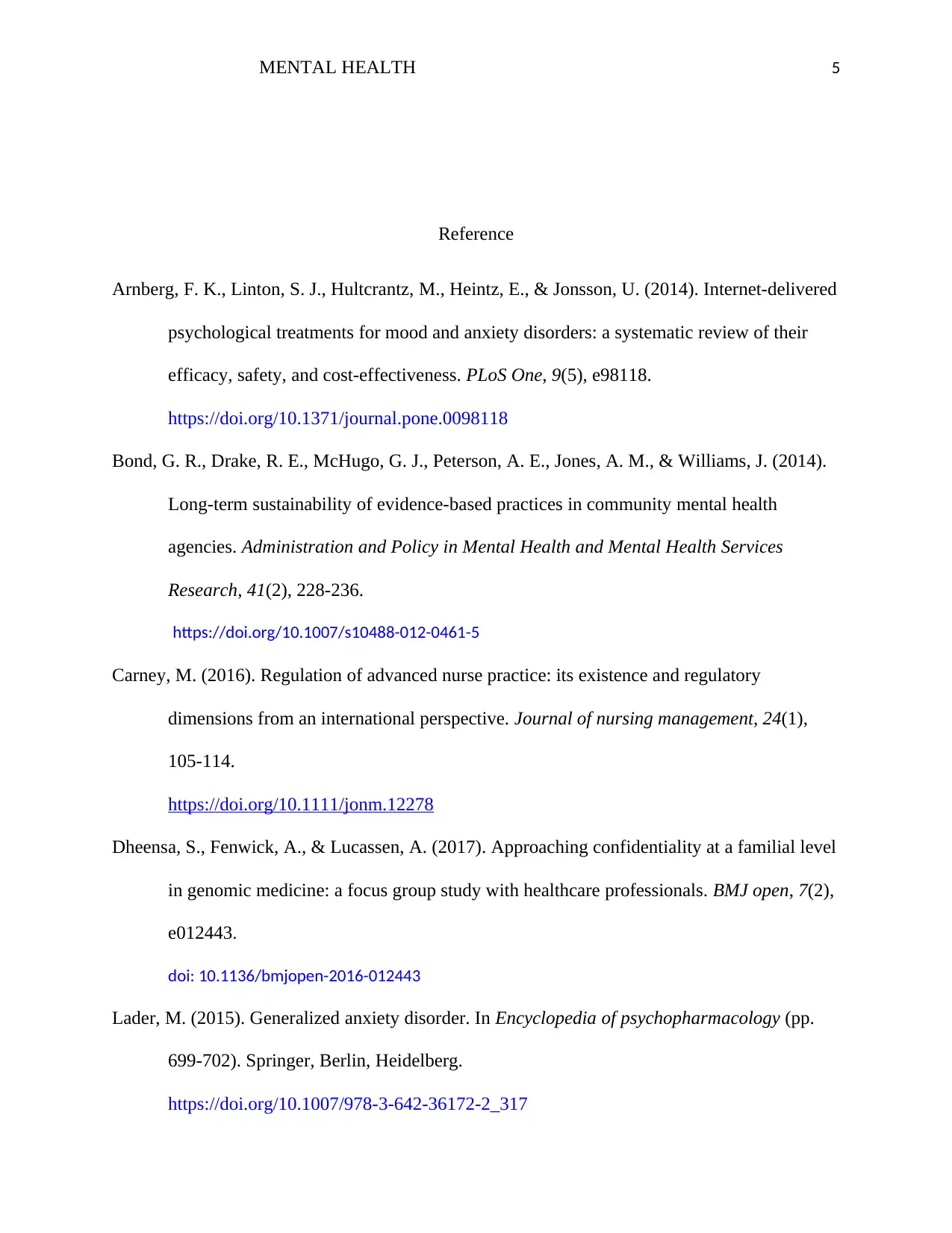
MENTAL HEALTH 5
Reference
Arnberg, F. K., Linton, S. J., Hultcrantz, M., Heintz, E., & Jonsson, U. (2014). Internet-delivered
psychological treatments for mood and anxiety disorders: a systematic review of their
efficacy, safety, and cost-effectiveness. PLoS One, 9(5), e98118.
https://doi.org/10.1371/journal.pone.0098118
Bond, G. R., Drake, R. E., McHugo, G. J., Peterson, A. E., Jones, A. M., & Williams, J. (2014).
Long-term sustainability of evidence-based practices in community mental health
agencies. Administration and Policy in Mental Health and Mental Health Services
Research, 41(2), 228-236.
https://doi.org/10.1007/s10488-012-0461-5
Carney, M. (2016). Regulation of advanced nurse practice: its existence and regulatory
dimensions from an international perspective. Journal of nursing management, 24(1),
105-114.
https://doi.org/10.1111/jonm.12278
Dheensa, S., Fenwick, A., & Lucassen, A. (2017). Approaching confidentiality at a familial level
in genomic medicine: a focus group study with healthcare professionals. BMJ open, 7(2),
e012443.
doi: 10.1136/bmjopen-2016-012443
Lader, M. (2015). Generalized anxiety disorder. In Encyclopedia of psychopharmacology (pp.
699-702). Springer, Berlin, Heidelberg.
https://doi.org/10.1007/978-3-642-36172-2_317
Reference
Arnberg, F. K., Linton, S. J., Hultcrantz, M., Heintz, E., & Jonsson, U. (2014). Internet-delivered
psychological treatments for mood and anxiety disorders: a systematic review of their
efficacy, safety, and cost-effectiveness. PLoS One, 9(5), e98118.
https://doi.org/10.1371/journal.pone.0098118
Bond, G. R., Drake, R. E., McHugo, G. J., Peterson, A. E., Jones, A. M., & Williams, J. (2014).
Long-term sustainability of evidence-based practices in community mental health
agencies. Administration and Policy in Mental Health and Mental Health Services
Research, 41(2), 228-236.
https://doi.org/10.1007/s10488-012-0461-5
Carney, M. (2016). Regulation of advanced nurse practice: its existence and regulatory
dimensions from an international perspective. Journal of nursing management, 24(1),
105-114.
https://doi.org/10.1111/jonm.12278
Dheensa, S., Fenwick, A., & Lucassen, A. (2017). Approaching confidentiality at a familial level
in genomic medicine: a focus group study with healthcare professionals. BMJ open, 7(2),
e012443.
doi: 10.1136/bmjopen-2016-012443
Lader, M. (2015). Generalized anxiety disorder. In Encyclopedia of psychopharmacology (pp.
699-702). Springer, Berlin, Heidelberg.
https://doi.org/10.1007/978-3-642-36172-2_317
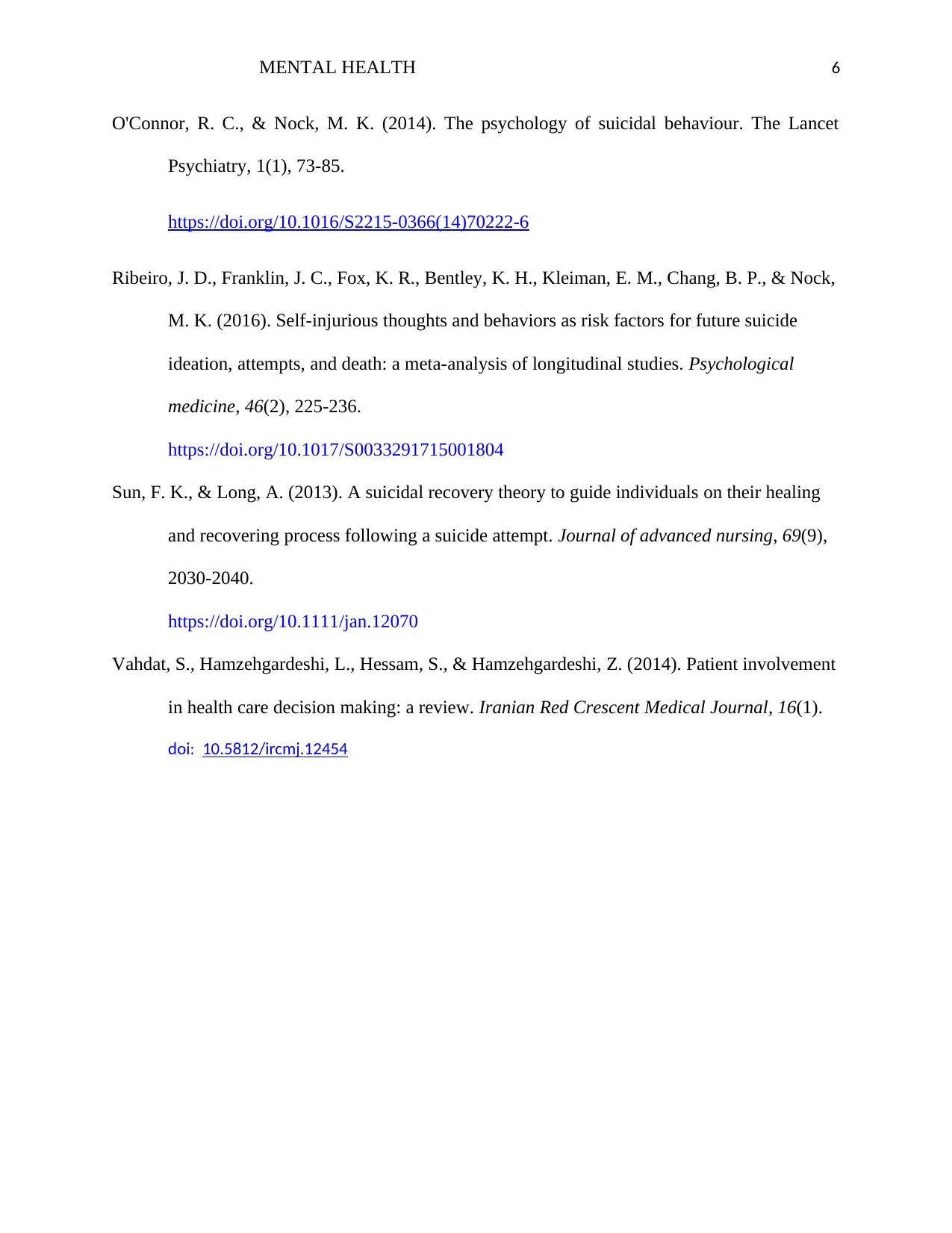
MENTAL HEALTH 6
O'Connor, R. C., & Nock, M. K. (2014). The psychology of suicidal behaviour. The Lancet
Psychiatry, 1(1), 73-85.
https://doi.org/10.1016/S2215-0366(14)70222-6
Ribeiro, J. D., Franklin, J. C., Fox, K. R., Bentley, K. H., Kleiman, E. M., Chang, B. P., & Nock,
M. K. (2016). Self-injurious thoughts and behaviors as risk factors for future suicide
ideation, attempts, and death: a meta-analysis of longitudinal studies. Psychological
medicine, 46(2), 225-236.
https://doi.org/10.1017/S0033291715001804
Sun, F. K., & Long, A. (2013). A suicidal recovery theory to guide individuals on their healing
and recovering process following a suicide attempt. Journal of advanced nursing, 69(9),
2030-2040.
https://doi.org/10.1111/jan.12070
Vahdat, S., Hamzehgardeshi, L., Hessam, S., & Hamzehgardeshi, Z. (2014). Patient involvement
in health care decision making: a review. Iranian Red Crescent Medical Journal, 16(1).
doi: 10.5812/ircmj.12454
O'Connor, R. C., & Nock, M. K. (2014). The psychology of suicidal behaviour. The Lancet
Psychiatry, 1(1), 73-85.
https://doi.org/10.1016/S2215-0366(14)70222-6
Ribeiro, J. D., Franklin, J. C., Fox, K. R., Bentley, K. H., Kleiman, E. M., Chang, B. P., & Nock,
M. K. (2016). Self-injurious thoughts and behaviors as risk factors for future suicide
ideation, attempts, and death: a meta-analysis of longitudinal studies. Psychological
medicine, 46(2), 225-236.
https://doi.org/10.1017/S0033291715001804
Sun, F. K., & Long, A. (2013). A suicidal recovery theory to guide individuals on their healing
and recovering process following a suicide attempt. Journal of advanced nursing, 69(9),
2030-2040.
https://doi.org/10.1111/jan.12070
Vahdat, S., Hamzehgardeshi, L., Hessam, S., & Hamzehgardeshi, Z. (2014). Patient involvement
in health care decision making: a review. Iranian Red Crescent Medical Journal, 16(1).
doi: 10.5812/ircmj.12454
⊘ This is a preview!⊘
Do you want full access?
Subscribe today to unlock all pages.

Trusted by 1+ million students worldwide
1 out of 6
Related Documents
Your All-in-One AI-Powered Toolkit for Academic Success.
+13062052269
info@desklib.com
Available 24*7 on WhatsApp / Email
![[object Object]](/_next/static/media/star-bottom.7253800d.svg)
Unlock your academic potential
Copyright © 2020–2025 A2Z Services. All Rights Reserved. Developed and managed by ZUCOL.

